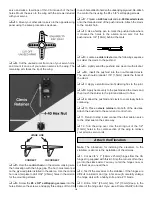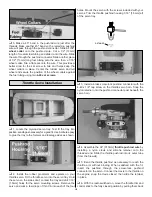
We recommend that you take it easy with your Giles for the
first several flights and gradually “get acquainted” with this
fantastic aircraft as your engine gets fully broken-in. Add and
practice one maneuver at a time, learning how she behaves
in each one.
When it’s time to land, make your approach as you would
any low-wing sport aircraft. If your Giles is assembled
straight and true, you’ll find that you can really flare it out for
slow landings without fear of tip stalling. Because the Giles
is such a forgiving aircraft, there are no bad habits to deal
with during landing. You will find it very easy to get the plane
down on the ground without pulling the throttle to a complete
idle. A little practice is all it takes to make 3-point landings
look easy.
Have a ball! But always stay in control and fly in a safe
manner.
Great Planes Extra 300S .40-size
Ideal for MinIMAC, Great Planes’ sport-scale Extra 300S kit
requires no more experience, expense or assembly work than the
average mid-size sport model. It minimizes building challenges
with CAD-engineered, perfectly interlocking parts, a photo-illustrated
instruction manual and accurate, full-size plans. The fully symmetrical
wing comes with preshaped and notched leading and trailing
edges, and D-tube construction to maximize strength. Economize
by using the engine from your .40-size sport trainer...or use a “hot”
.40 engine to fly unlimited vertical!
GPMA0235
Futaba
®
8UAPS PCM 8-Channel Radio
Since your eyes can’t leave your plane, all trims beep as they pass
neutral. You can trim your plane by ear! The 8UAPS also offers 8
model memory; a large LCD screen for programming ease;
programmable mixing; side-to-side adjustable exponential; all-
channel failsafe; digital trims and automatic trim memory; Direct
Servo Control; programmable switch location and trainer function;
full NiCds; charger; 60-minute stopwatch and more. 72MHz.
FUTJ81**
OTHER ITEMS AVAILABLE FROM
GREAT PLANES
Landing
CAUTION (THIS APPLIES TO ALL R/C AIRPLANES):
If,
while flying, you notice any unusual sounds, such as a
low-pitched “buzz,” this may be an indication of control
surface “flutter.” Because flutter can quickly destroy
components of your airplane, any time you detect flutter
you must
immediately
cut the throttle and land the
airplane! Check all servo grommets for deterioration (this
will indicate which surface fluttered), and make sure all
pushrod linkages are slop-free. If it fluttered once, it will
probably flutter again under similar circumstances unless
you can eliminate the slop or flexing in the linkages. Here
are some things which can result in flutter: Excessive
hinge gap; Not mounting control horns solidly; Sloppy fit
of clevis pin in horn; Elasticity present in flexible plastic
pushrods; Side-play of pushrod in guide tube caused by
tight bends; Sloppy fit of Z-bend in servo arm; Insufficient
glue used when gluing in the elevator joiner wire or aileron
torque rod; Excessive flexing of aileron, caused by using
too soft balsa aileron; Excessive “play” or “backlash” in
servo gears; and Insecure servo mounting.
Flying
25


















